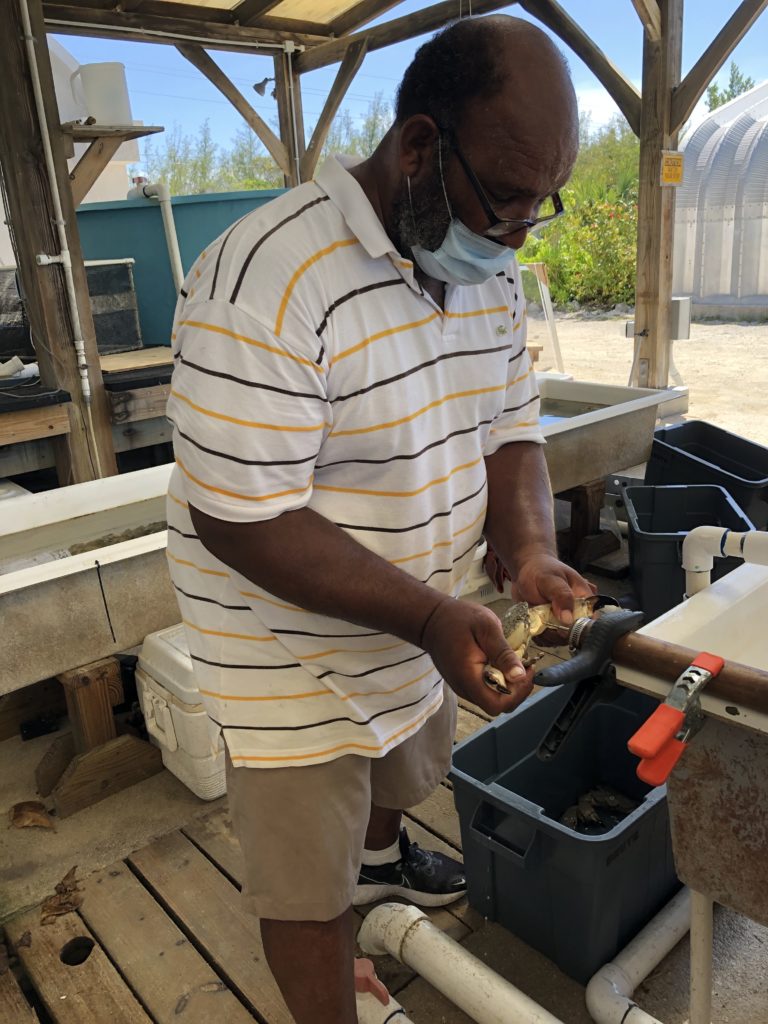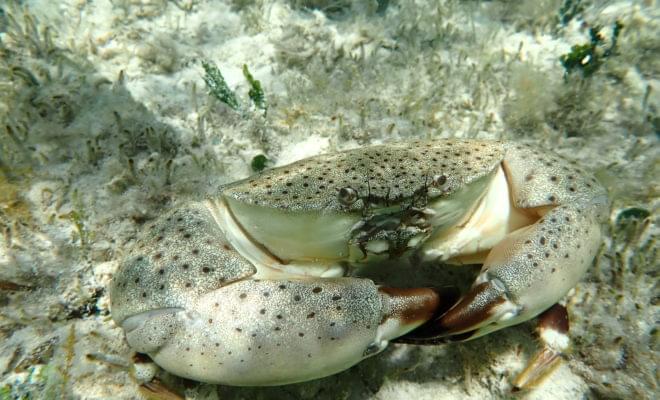Ground-breaking research on the stone crab fishery in The Bahamas has identified an alternative method for claw removal that increases the chances of stone crab survival by nearly 30% once their claw is harvested and the crab is released. This work was done in collaboration with local fishers by the Cape Eleuthera Institute (CEI) at The Island School with support and funding from the Moore Bahamas Foundation.
The New Method
The new method takes advantage of a self defense strategy that crabs and some other animals use to avoid predators. Have you ever seen a lizard drop its tail off? This may happen when the animal feels threatened, and similarly, crabs can actively drop a claw off to increase their chances of survival if they are under attack. By simply sticking a sharp object into the soft joint mid-way down the claw, a fisher can make the crab drop its claw which avoids damage to the joint that can occur when cracking or clipping the claw off. When a crab drops its claw, survival increases by 29% on average, meaning more crabs survive to regrow their claws and reproduce, thus supporting the population and the fishery into the future. Local fishers helped develop the slogan, “Don’t clip the biter, stick it” to communicate the alternate claw removal technique.
To see this technique in action, check out our video below.
Fisher Input and Expertise
Following their initial research, the team met with stone crab fishers, processors, and exporters on Eleuthera, Abaco, Grand Bahama, and New Providence. The research findings were shared with participants, and the research team engaged expert fishers in a discussion to hear their feedback and advice on the feasibility of implementing this different harvest method in the commercial stone crab fishery. The CEI research team asked fishers to try the claw removal method this stone crab season and report back on if it could work on their boats.
Some important concerns were raised by fishers, processors, and exporters which included:
- the time to induce a crab to drop its claw
- food safety and aesthetics of the crab claws
- fisher safety working with a sharp object
One theme that emerged through all the meetings was the additional time it would take to process crabs, because some crabs do not instantly drop their claws following the puncture, adding several seconds to each repetitive action. At present, a consensus was reached that this method is not yet ready for commercial implementation, and needs to be tested this season so that fishers can share their recommendations and identify best practices.

Testing the Method & Gathering Feedback
The stone crab season is open from October 16th – May 31st each year, and this season presents an exciting opportunity to continue this work. A number of fishers that attended the meetings have agreed to try the new method and report back with suggestions: as with anything, it may take some practice to find a fast, safe, and reliable way to stick a claw and drop it off. Additionally, food safety administrators and commercial buyers in the US are being consulted to ensure all concerns are being addressed.
The National Fisheries Association and stone crab fishers that have worked on the project have been incredibly supportive of this collaborative effort to investigate a new idea. The opening of the fishing season presents a timely opportunity to continue to test this new method and learn more about the stone crab fishery. However, while the increase in survival rates is promising, this technique needs to be further tested by fishers to gather their input and feedback. The Cape Eleuthera Institute does not recommend this method be regulated or mandated in the commercial fishery at this time.
This work was carried out side-by-side with commercial fishers who have played an integral part in the process of ensuring Bahamian fisheries operate to a high degree of sustainability. Stone crab claws in The Bahamas are larger on average than those in Florida, and this has resulted in a successful export market developing. Unlike most seafood that is priced the same per pound, stone crab claws are more valuable the larger they are, so it is important to maintain a healthy population of large crabs in The Bahamas for the export market to thrive. Stakeholder direction and support is vital to fisheries research and management, so we are excited to continue this project using feedback from fishers to ensure this resource is available for future generations.
Want to get involved?
- Try this claw removal method during the stone crab season from October 16th – May 31st
- If you find a way that works on your boat, let us know at research@ceibahamas.org
And remember, “Don’t clip the biter, stick it”!
